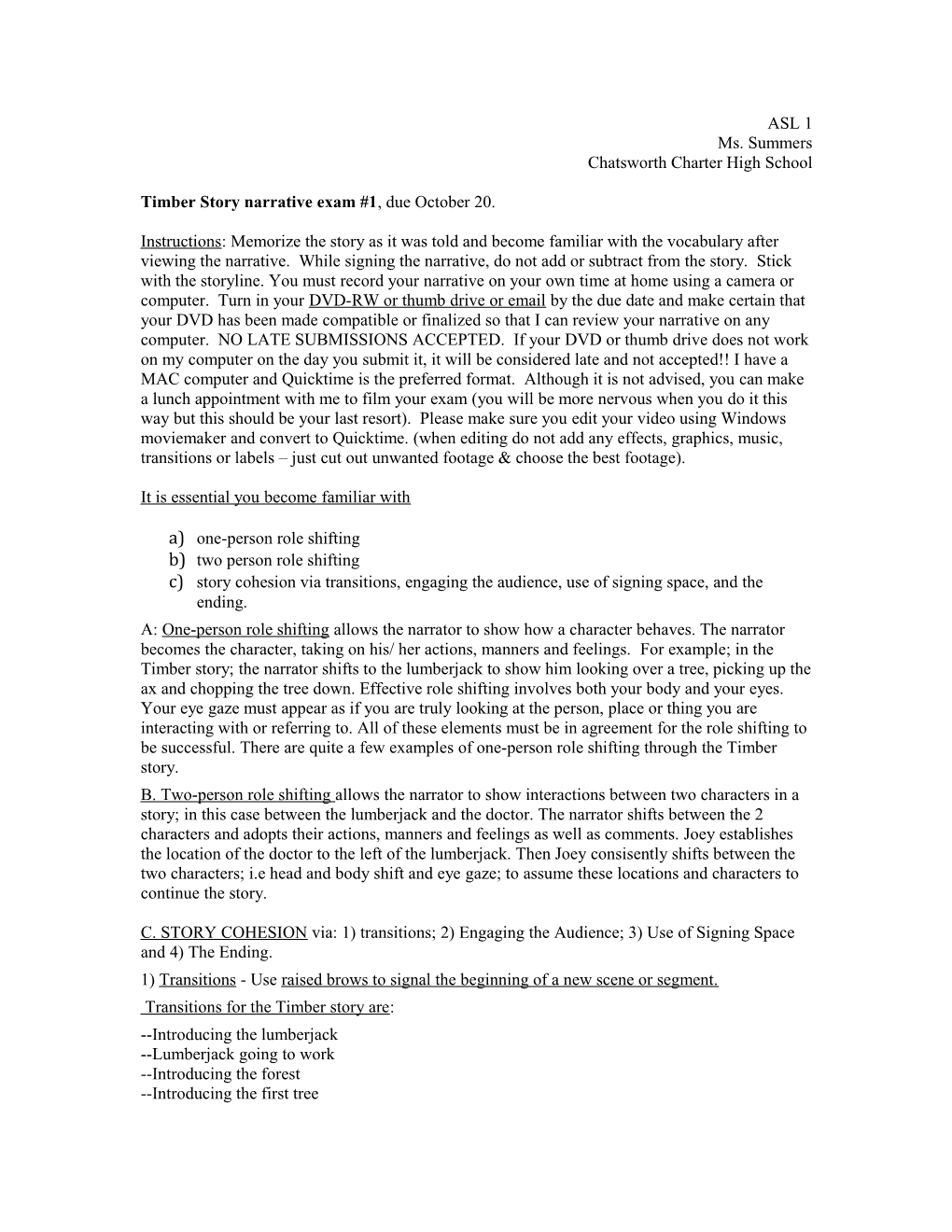ASL 1
Ms. Summers
Chatsworth Charter High School
Timber Story narrative exam #1, due October 20.
Instructions: Memorize the story as it was told and become familiar with the vocabulary after viewing the narrative. While signing the narrative, do not add or subtract from the story. Stick with the storyline. You must record your narrative on your own time at home using a camera or computer. Turn in your DVD-RW or thumb drive or email by the due date and make certain that your DVD has been made compatible or finalized so that I can review your narrative on any computer. NO LATE SUBMISSIONS ACCEPTED. If your DVD or thumb drive does not work on my computer on the day you submit it, it will be considered late and not accepted!! I have a MAC computer and Quicktime is the preferred format. Although it is not advised, you can make a lunch appointment with me to film your exam (you will be more nervous when you do it this way but this should be your last resort). Please make sure you edit your video using Windows moviemaker and convert to Quicktime. (when editing do not add any effects, graphics, music, transitions or labels – just cut out unwanted footage & choose the best footage).
It is essential you become familiar with
a) one-person role shifting
b) two person role shifting
c) story cohesion via transitions, engaging the audience, use of signing space, and the ending.
A: One-person role shifting allows the narrator to show how a character behaves. The narrator becomes the character, taking on his/ her actions, manners and feelings. For example; in the Timber story; the narrator shifts to the lumberjack to show him looking over a tree, picking up the ax and chopping the tree down. Effective role shifting involves both your body and your eyes. Your eye gaze must appear as if you are truly looking at the person, place or thing you are interacting with or referring to. All of these elements must be in agreement for the role shifting to be successful. There are quite a few examples of one-person role shifting through the Timber story.
B. Two-person role shifting allows the narrator to show interactions between two characters in a story; in this case between the lumberjack and the doctor. The narrator shifts between the 2 characters and adopts their actions, manners and feelings as well as comments. Joey establishes the location of the doctor to the left of the lumberjack. Then Joey consisently shifts between the two characters; i.e head and body shift and eye gaze; to assume these locations and characters to continue the story.
C. STORY COHESION via: 1) transitions; 2) Engaging the Audience; 3) Use of Signing Space and 4) The Ending.
1) Transitions - Use raised brows to signal the beginning of a new scene or segment.
Transitions for the Timber story are:
--Introducing the lumberjack
--Lumberjack going to work
--Introducing the forest
--Introducing the first tree
--Introducing the 2nd tree
--Introducing the last tree
--Physician arriving at the scene.
2) Engaging the Audience: To tell the story well; you must engage the audience. One way to do this is by making eye contact with the audience i.e. you, the students and maintaining the eye contact throughout the narrative. This way, the listener is more attention to the story. The only time; the narrator breaks his eye gaze with you is when he role shifts into a character i.e the lumberjack or the doctor. So when you record your Timber story on camera; imagine the camera as your audience and remember that the only time you look away from the camera is when you role shift.
It is important to be enthusiastic when narrating your story. You do this by stepping into the story and make it come alive.
3) Use of Signing Space: To make your story visually appealing, focus on making your signs larger and deliberate. Just remember that when you record; make sure your arms or hands get cut off on camera. Remember to sign from head to waist.
4) The Ending: To tell this story well especially with the 3rd tree; spell the word "Timber" in a more dramatic fashion. Also, showing the tree landing hard on the ground and concluding the story with the "thumbs up" exchange between the lumberjack and the doctor; and finally with the audience.
Day of Filming: Be sure to:
--wear solid color clothes
--if your hair falls into your eyes, pin it back or wear a ponytail
--don't wear hats (unless it has no brim) due to the shadows hiding your face.
--you should have nothing in your mouth - no candy or gum while filming.
--make sure you have adequate lighting on you from head to waist.
Reminder: Either submit a DVD-RW or thumb drive to me on the due date. Make sure it's disc compatible or finalized before you turn it in.
